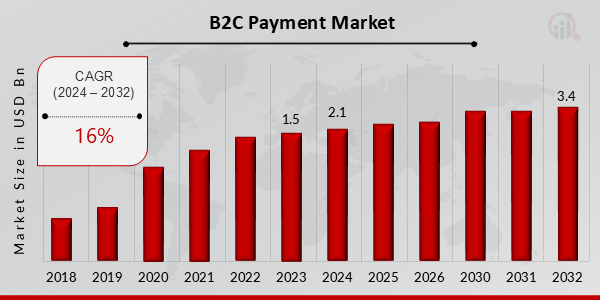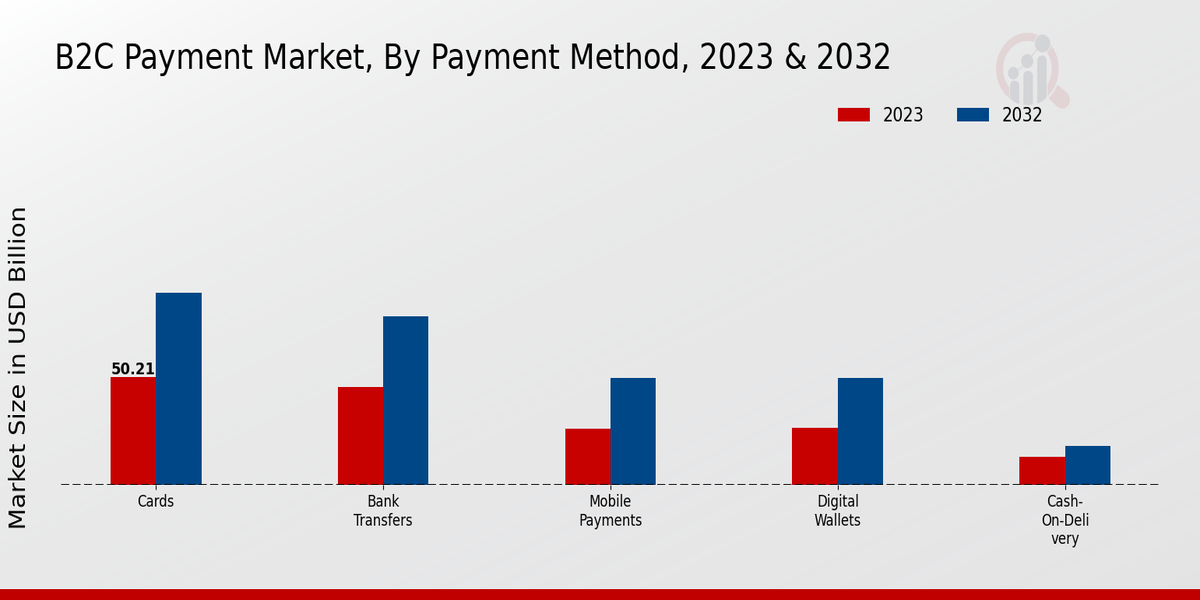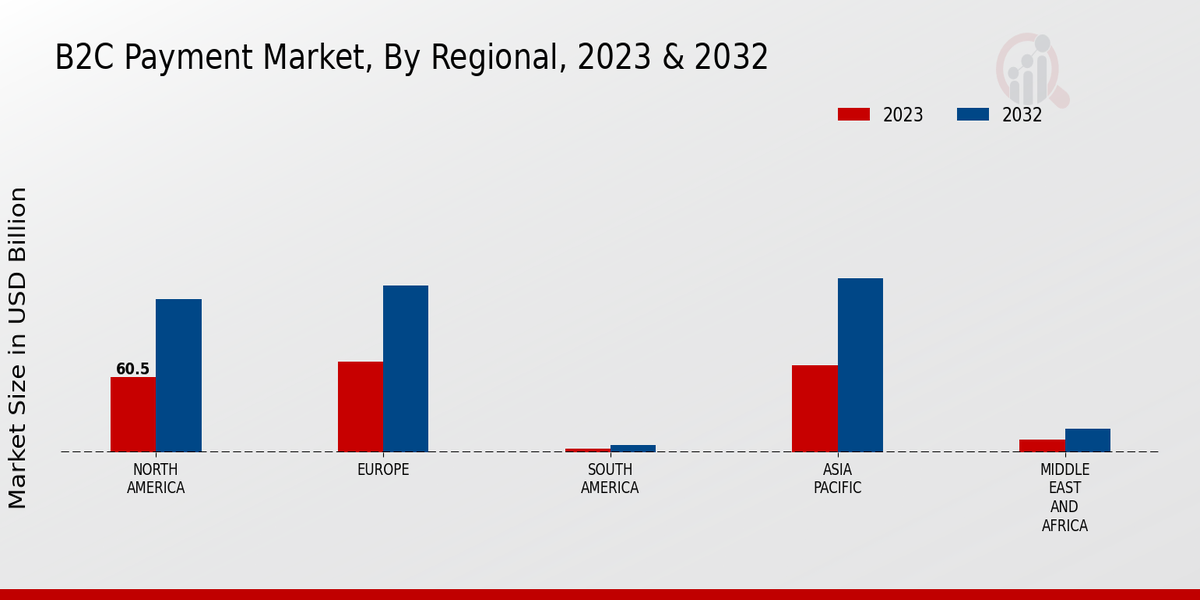Global B2C Payment Market Overview:
B2C Payment Market Size was estimated at 1.5 (USD Billion) in 2023. The B2C Payment Market Industry is expected to grow from 2.1 (USD Billion) in 2024 to 3.4 (USD Billion) by 2032. The B2C Payment Market CAGR (growth rate) is expected to be around 16% during the forecast period (2024 - 2032).
Key B2C Payment Market Trends Highlighted
The B2C payment market is experiencing a surge in digital adoption, fueled by the rise of e-commerce and mobile banking. Contactless payments have gained significant traction, particularly in the wake of the COVID-19 pandemic, due to heightened concerns over hygiene and safety. Additionally, the adoption of mobile wallets and QR code-based payments has been pivotal in driving the growth of cashless transactions. Key market drivers include increasing smartphone penetration, improving internet connectivity, and rising consumer demand for convenient and secure payment methods. Opportunities lie in the expansion of digital payment platforms into underserved regions, the integration of advanced technologies such as biometrics and artificial intelligence into payment systems, and the growing popularity of subscription-based services.

Source: Primary Research, Secondary Research, MRFR Database and Analyst Review
B2C Payment Market Drivers
Growing Popularity of E-commerce
The B2C payment market is primarily driven by the rapid growth of e-commerce, which has revolutionized the retail industry. The convenience and accessibility of online shopping have led to a surge in consumer spending, particularly in emerging markets. The increasing penetration of smartphones and the expansion of internet connectivity have further fueled the growth of e-commerce, making it easier for consumers to purchase goods and services online. As a result, there is a growing demand for secure and efficient payment solutions that can facilitate seamless transactions in the digital space.
Increased Adoption of Digital Wallets
Digital wallets have emerged as a key driver of growth in the B2C payment market. These wallets offer consumers a convenient and secure way to store and manage their payment information, eliminating the need to carry physical cash or cards. The rising popularity of mobile payments and the growth of mobile commerce have contributed to the widespread adoption of digital wallets. Additionally, the integration of digital wallets with loyalty programs and other value-added services has further enhanced their appeal among consumers.
Growing Demand for Contactless Payments
Contactless payments have gained significant traction in recent years, driven by concerns about hygiene and the need for faster and more convenient payment methods. Contactless payment technologies, such as near-field communication (NFC) and radio-frequency identification (RFID), allow consumers to make payments by simply tapping their payment device on a reader. The growing adoption of contactless payments in retail stores, restaurants, and other public places is contributing to the growth of the B2C payment market.
B2C Payment Market Segment Insights:
B2C Payment Market Payment Method Insights
The B2C Payment Market is segmented by Payment Method into Cards, Bank Transfers, Mobile Payments, Digital Wallets, and Cash-on-Delivery. Among these, Cards held the largest market share in 2023, accounting for over 50% of the B2C Payment Market revenue. The dominance of Cards can be attributed to their wide acceptance, convenience, and security features. However, Mobile Payments and Digital Wallets are projected to witness significant growth in the coming years due to the increasing adoption of smartphones and the growing popularity of online shopping. Bank Transfers remain a popular payment method, particularly for high-value transactions. Cash-on-Delivery, while still prevalent in certain regions, is gradually losing ground to other payment methods due to concerns over security and the need for physical presence during delivery. The growth of the market is driven by factors such as the increasing penetration of e-commerce, the growing adoption of digital payment methods, and the rising disposable income of consumers.

Source: Primary Research, Secondary Research, MRFR Database and Analyst Review
B2C Payment Market Business Model Insights
The B2C Payment Market is segmented by business model into merchant-acquiring, payment gateway, payment processing, payment facilitation, and point-of-sale (POS) systems. The merchant-acquiring segment is expected to hold the largest market share in 2023, accounting for over 40% of the global revenue. This segment is dominated by large players such as Visa and Mastercard, which provide services to merchants to accept payments from customers. The payment gateway segment is expected to grow at the highest CAGR during the forecast period, driven by the increasing adoption of e-commerce and the need for secure online payment solutions. Key players in this segment include PayPal, Stripe, and Amazon Pay. The payment processing segment includes companies that provide services to process payments, such as clearing and settlement. Major players in this segment include Fiserv and Fidelity National Information Services. The payment facilitation segment includes companies that provide services to facilitate payments between merchants and customers, such as mobile wallets and digital payment platforms. Key players in this segment include Apple Pay, Google Pay, and Samsung Pay. The POS systems segment includes companies that provide hardware and software solutions to enable merchants to accept payments in-store. Major players in this segment include Ingenico, Verifone, and NCR.
B2C Payment Market End-User Vertical Insights
The B2C Payment Market is segmented into various end-user verticals, including Retail, E-commerce, Travel and Hospitality, Media and Entertainment, Healthcare, and Education. Among these, the Retail segment holds a significant market share, accounting for approximately 35.2% of the overall market revenue in 2023. The E-commerce segment follows closely, capturing around 28.1% of the market share. The Travel and Hospitality segment is projected to witness substantial growth, with a CAGR of 8.5% during the forecast period of 2023-2032. The Media and Entertainment segment is estimated to reach a market size of USD 15.4 billion by 2032, growing at a CAGR of 7.8%. The Healthcare segment is anticipated to expand at a CAGR of 6.9%, driven by the increasing adoption of digital payment solutions in healthcare facilities. The Education segment is also expected to experience significant growth, with a CAGR of 6.3%, as more educational institutions embrace online payment systems for tuition fees and other expenses.
B2C Payment Market Technology Insights
Technological advancements have significantly influenced the B2C payment landscape. Leading-edge technologies like blockchain, artificial intelligence (AI), cloud computing, biometrics, and the Internet of Things (IoT) are transforming the way consumers make payments. Blockchain technology enhances security and transparency in B2C payments. It enables secure and immutable transaction records, reducing fraud and chargebacks. Artificial intelligence (AI) streamlines payment processes, personalizes customer experiences, and detects fraudulent activities. Cloud computing provides scalable and cost-effective infrastructure for B2C payment platforms, allowing for seamless transaction processing. Biometrics offers advanced security measures, enabling convenient and secure payments through fingerprint or facial recognition. The Internet of Things (IoT) connects devices to the internet, allowing for innovative payment methods like wearable devices and smart home assistants. These technologies are revolutionizing the B2C payment industry, offering enhanced convenience, security, and efficiency.
B2C Payment Market Regulatory Landscape Insights
The regulatory landscape for the B2C Payment Market is complex and evolving. There are a number of key regulations that impact the industry, including the Payment Card Industry Data Security Standard (PCI DSS), the General Data Protection Regulation (GDPR), the United States Dodd-Frank Wall Street Reform and Consumer Protection Act, Europe's Second Payment Services Directive (PSD2), and China's Cross-Border E-commerce Retail Import Regulations. These regulations impose a number of requirements on B2C payment providers, including data security, privacy, and consumer protection. The B2C Payment Market revenue is expected to reach $85.34 billion in 2023 and $159.8 billion by 2032, exhibiting a CAGR of 7.22%. The increasing adoption of digital payments, the growth of e-commerce, and the rising disposable income are the major factors driving the growth of the B2C Payment Market. PCI DSS is a set of security standards that are designed to protect cardholder data. GDPR is a data protection regulation that gives EU residents control over their personal data. Dodd-Frank is a financial reform law that includes provisions related to consumer protection in the financial sector.PSD2 is a payment services directive that regulates electronic payments within the European Union. China's Cross-Border E-commerce Retail Import Regulations are designed to regulate the import of goods into China through e-commerce channels. B2C payment providers must comply with these regulations in order to operate in their respective markets. Failure to comply can result in fines, penalties, and other legal consequences. The regulatory landscape is constantly evolving, so B2C payment providers must stay up to date on the latest changes in order to remain compliant.
B2C Payment Market Regional Insights
The regional segmentation of the B2C Payment Market offers valuable insights into the diverse market dynamics across different regions. North America is expected to dominate the market, driven by the high adoption of digital payment technologies, a large consumer base, and the presence of major industry players. Europe follows closely, with a robust e-commerce market and a growing preference for cashless transactions. APAC is poised for significant growth, fueled by the rapidly expanding middle class, increasing internet and smartphone penetration, and government initiatives promoting digital payments. South America has a growing potential, particularly in Brazil and Argentina, due to the rising adoption of mobile payments and the expansion of e-commerce. MEA is expected to witness a steady growth, driven by increasing smartphone usage, the growth of online retail, and government efforts to promote financial inclusion.

Source: Primary Research, Secondary Research, MRFR Database and Analyst Review
B2C Payment Market Key Players And Competitive Insights:
Major players in the B2C Payment Market industry are constantly striving to gain a competitive edge by introducing innovative products and services. Leading B2C Payment Market players are focusing on developing advanced technologies such as artificial intelligence (AI) and machine learning (ML) to enhance the customer experience and streamline payment processes. Strategic partnerships and collaborations are also becoming increasingly common as companies seek to expand their reach and offer a wider range of services. The competitive landscape of the B2C Payment Market is expected to remain highly dynamic in the coming years, with new entrants and established players vying for market share. A leading player in the B2C Payment Market is PayPal Holdings, Inc. The company offers a range of payment solutions, including online payments, mobile payments, and in-store payments. PayPal has a strong global presence with operations in over 200 countries and territories. The company's key strengths include its large customer base, its user-friendly platform, and its robust security measures. PayPal is continuously investing in new technologies to enhance its offerings and maintain its competitive edge. A notable competitor in the B2C Payment Market is Mastercard Incorporated. The company provides a range of payment products and services, including credit cards, debit cards, and prepaid cards. Mastercard has a global presence with operations in over 210 countries and territories. The company's key strengths include its extensive network of merchants, its strong brand recognition, and its focus on innovation. Mastercard is continuously investing in new technologies to enhance its offerings and compete effectively in the dynamic B2C Payment Market.
Key Companies in the B2C Payment Market Include:
B2C Payment Industry Developments
The B2C payment market is experiencing significant growth, driven by the increasing adoption of digital payments and the rise of e-commerce. In 2023, the market was valued at USD 85.34 billion, and it is projected to reach USD 159.8 billion by 2032, exhibiting a CAGR of 7.22%. Key trends shaping the market include the proliferation of mobile payments, the emergence of new payment technologies such as biometrics and blockchain, and the growing popularity of subscription-based services. Recent developments include the launch of new digital wallets and payment platforms, as well as partnerships between payment providers and retailers to enhance customer convenience and security.
B2C Payment Market Segmentation Insights
-
B2C Payment Market Payment Method Outlook
-
Cards
-
Bank Transfers
-
Mobile Payments
-
Digital Wallets
-
Cash-on-Delivery
-
B2C Payment Market Business Model Outlook
-
B2C Payment Market End-User Vertical Outlook
-
Retail
-
E-commerce
-
Travel and Hospitality
-
Media and Entertainment
-
Healthcare
-
Education
-
B2C Payment Market Technology Outlook
-
B2C Payment Market Regulatory Landscape Outlook
-
Payment Card Industry Data Security Standard (PCI DSS)
-
General Data Protection Regulation (GDPR)
-
United States Dodd-Frank Wall Street Reform and Consumer Protection Act
-
Europe's Second Payment Services Directive (PSD2)
-
China's Cross-Border E-commerce Retail Import Regulations
-
B2C Payment Market Regional Outlook
-
North America
-
Europe
-
South America
-
Asia Pacific
-
Middle East and Africa
| Report Attribute/Metric |
Details |
| Market Size 2023 |
1.5 (USD Billion) |
| Market Size 2024 |
2.1 (USD Billion) |
| Market Size 2032 |
3.4 (USD Billion) |
| Compound Annual Growth Rate (CAGR) |
16% (2024 - 2032) |
| Report Coverage |
Revenue Forecast, Competitive Landscape, Growth Factors, and Trends |
| Base Year |
2023 |
| Market Forecast Period |
2024 - 2032 |
| Historical Data |
2019 - 2023 |
| Market Forecast Units |
USD Billion |
| Key Companies Profiled |
HSBC Holdings, Barclays, Commonwealth Bank of Australia, Bank of America, Morgan Stanley, Mitsubishi UFJ Financial Group, Deutsche Bank, Citigroup, Wells Fargo, Goldman Sachs, BNP Paribas, Groupe BPCE, Credit Suisse, UBS, JPMorgan Chase Co. |
| Segments Covered |
Payment Method, Business Model, End-User Vertical, Technology, Regulatory Landscape, Regional |
| Key Market Opportunities |
Cross border e-commerce growth Mobile payment adoption. Rising demand for BNPL Blockchain based payment systems. Increased focus on digital security. |
| Key Market Dynamics |
Rising ecommerce digital wallet adoption mobile payments fintech innovation and government regulations |
| Countries Covered |
North America, Europe, APAC, South America, MEA |
Frequently Asked Questions (FAQ) :
The B2C Payment Market is expected to reach USD 3.4 billion by 2032, growing at a CAGR of 16% from 2024 to 2032.
The key regions in the B2C Payment Market are North America, Europe, Asia-Pacific, Latin America, and the Middle East and Africa.
Major applications of B2C payments include e-commerce, travel, entertainment, and utilities.
Key competitors in the B2C Payment Market include PayPal, Visa, Mastercard, American Express, and Apple Pay.
Major trends in the B2C Payment Market include the rise of mobile payments, the adoption of digital wallets, and the increasing popularity of cryptocurrency payments.
Challenges facing the B2C Payment Market include security concerns, regulatory compliance, and the need for interoperability between different payment systems.
The B2C Payment Market has significant growth potential, driven by the increasing adoption of e-commerce and the growing popularity of digital payments.
Key factors driving the growth of the B2C Payment Market include the rising number of internet users, the increasing popularity of mobile devices, and the growing adoption of digital payment solutions.
Key opportunities for businesses in the B2C Payment Market include developing innovative payment solutions, expanding into new markets, and partnering with other businesses to offer complementary services.
Key challenges for businesses in the B2C Payment Market include competition from established players, the need to invest in technology and innovation, and the need to comply with regulatory requirements.

















